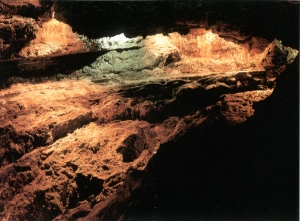Cueva De Los Verdes

Reputedly the longest volcanic cave in the world, the Cueva de los Verdes ("The Greens Cave") is one of Lanzarotes most fascinating landmarks, but its history is little known and shrouded in mystery.
Even the name itself is something of an enigma. Does the "green" refer to the apparent colour of the eerie interior of the seven-kilometre long underground cave Or was it the secret hideout of a wealthy Lanzarote family known as Los Verdes, ("The Greens") who considered the cave to be part of their own estate Local historians have favoured the latter theory, although the documented existence of such a family has never been reliably confirmed.
One thing is for sure The Cueva de los Verdes has served the islanders of Lanzarote very well over the centuries. In past years, the cave was a sanctuary not only from piratical raiding parties, but also from the raging volcanic eruptions which rocked the island in the 18th and 19th centuries.
The Cueva de los Verdes stretches underground from the volcano known as "La Corona" through to the sea on the north east coast. The tunnel was blasted through the earth under the effect of exploding lava more than four millenia ago, rather like an enormous exhaust pipe.
Within recent years, the island government and the local authority of Haria have carried out extensive work on the cave, providing illumination, ambient music and safe pathways for the interested visitor. An hour--long guided tour covering more than two kilometres of underground exploration, includes an explanation of the legends of the cave, plus a sound and light show.
On entering the Cueva de los Verdes, the visitor sees parts of the cave from three distinct galleries. From one of these, called "Hell", you can see one of the most spectacular examples of petrified lava in the world. The macabre effect resulted from molten lava, at a temperature of around 800 deg. C, suddenly coming into contact with air and solidifying almost immediately.
Strange natural statues seem to grow from the interior of the illuminated caves when viewed from other galleries. The figures range from Queen Victoria to Quasimodo, depending on the visitors imagination.
The true extent of the caves tortuous subterranean passages only became apparent some 100 years ago. And even today, some of the smaller tunnels have yet to be fully expored. A recent attempt by a Spanish research team had to be abandoned when divers ran low on air in an underwater passage.
Geologists believe the eruption which formed the main part of the cave occurred some 4,500 years ago, although later eruptions contributed to the formation of some of the minor caverns.
Theories abound on how the cave has been used as a refuge throughout Lanzarotes history.
One such story relates to the Moors persecution of the Jews on the Spanish mainland. (Remember the Moors governed Spain for almost eight hundred years). A colony of Jews fled from their homeland in the south of Spain and arrived on Lanzarote in the 15th century in an attempt to lead a normal life, living within the Jewish faith and free from the intolerance of the Islamic rulers.
Despite their arrival on the island, their persecution had not ended. Moorish ships searched for the Jewish fugitives and sent raiding parties to Lanzarote. The Jews had got to know about the Cueva de los Verdes and hid in its cavernous labyrinth until it was safe to venture out once more.
Meanwhile, marauding pirates, their ships laying heavy in the sea with booty from the Spanish Main, would often call at the Canary Islands, intending to add to their ill-gotten gains.
Many such buccaneers raided Lanzarote throughout the 16th and 17th centuries, and were often astonished to find deserted villages with no sign of anyone. On such occasions, thousands of terrified islanders, heeding the tolling of steeple bells, poured into the haven of the Cueva de los Verdes, to be soon lost inside its myriad tunnels.
The problem for the pirates was then not just finding the islanders, but locating the entrance to their hiding place. Not so today, however, since the cave is well sign--posted and has deservedly become one of the islands most frequented haunts.